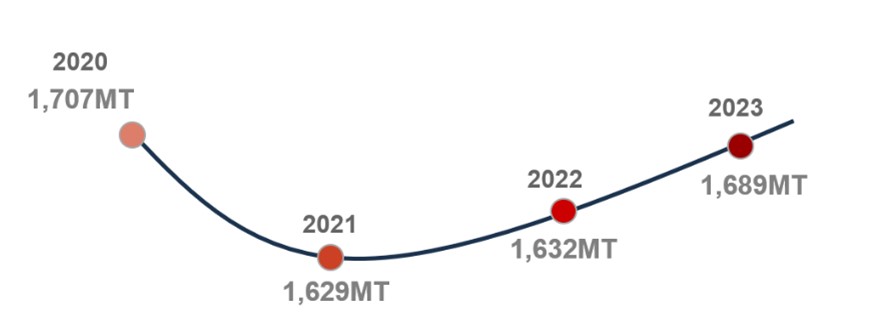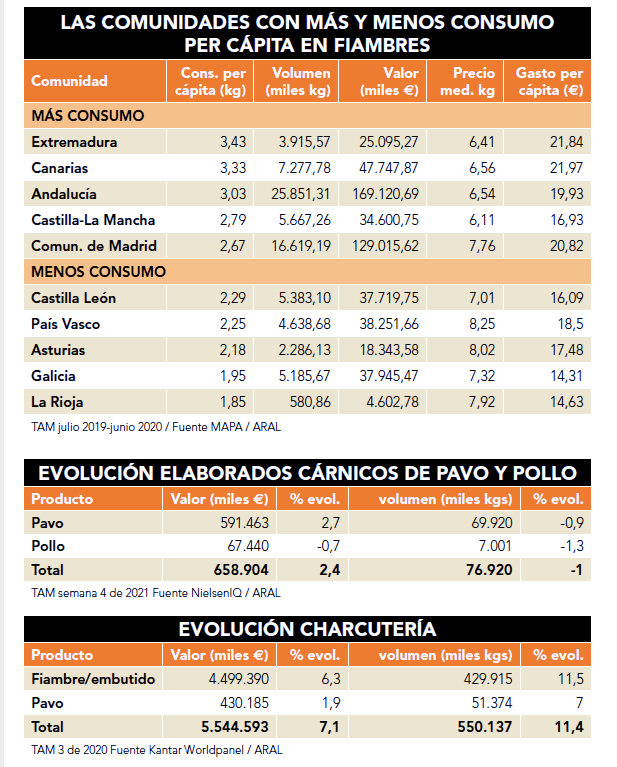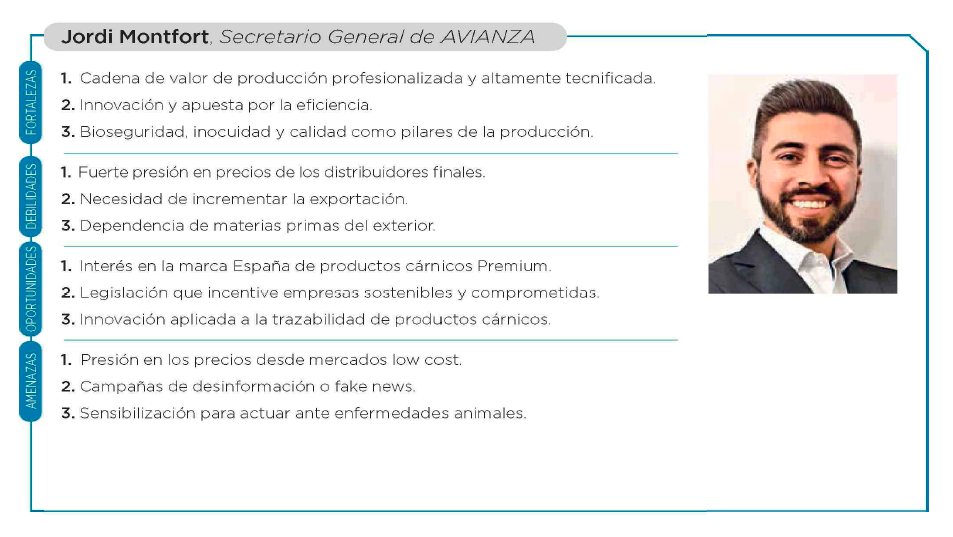This year has been marked by a process of recovery in demand for poultry meat, which reaches production values of 2021, but with a high cost of profitability after 2 years of price increases in raw materials, energy, inputs and inflation
● The launch of “Aves de España” as a new guarantee brand for consumers and for the sector, as well as promotional actions among consumers to show the properties of Spanish poultry meat, have been its pillars of action.
● One of these actions has been the “European Poultry” campaign, co-financed by the European Commission, and which has reached more than 20 million people in the last two years.
Madrid, December 21, 2023.- Avianza, the Spanish Interprofessional Poultry Meat Association, takes stock of 2023 with a vision of the sector's activity during the last year. From the poultry meat production indices, which reach 2021 levels, with a forecast of reaching 1,681,722 tons (chicken, turkey and quail), compared to 1,632,740 in 2022.
However, the increase does not yet cover the great economic efforts to face the successive crises of the last two years, nor the increase in production costs associated with our activity.
Despite everything, the association has pursued two main objectives:
- The promotion of Spanish poultry meat among Spanish consumers, positioning itself around three values: Sustainability, Animal Welfare and Food Safety. For this, it has had the support of the Ministry of Agriculture, Fisheries and Food, Food of Spain, or the European Commission, with co-financed projects that are added to the investment of the partners themselves.
- The second major objective has been the internationalization of our sector, with the opening of new markets such as Mexico, the reinforcement of the actions started with ICEX in the United Arab Emirates, a priority market, or the anticipation of receiving trade missions from China, the Philippines or Singapore.
All this without forgetting a great claim: the recognition of Spanish poultry meat as a representative of the Spain brand and our gastronomic wealth, as well as our contribution to healthy, affordable and safe eating.
Main activity indicators of the Spanish poultry sector
In 2023, production has increased by 2.5%, with an increase in the average weight of the birds. Household consumption has recovered in relation to 2022, becoming a refuge product for households in 2023.
SECTOR EVOLUTION:


Initiatives for internationalization
Actions to generate new business opportunities and opening of markets for the Spanish poultry meat sector in the United Arab Emirates, thanks to the framework agreement with ICEX and the Poultry from Spain initiative. In addition, we proceed to open the Mexico market.
Thus, in our mission in Dubai, Spanish poultry meat was the protagonist thanks to the support of ICEX, the Economic and Commercial Office of the Spanish Embassy in Dubai and SOPEXA.
Furthermore, in 2024, actions have been confirmed to attract companies in the distribution and restaurant sector to markets such as the Philippines, China, or Singapore, among others.
It is time to look outside Europe for poultry exports. After the closure of important markets for France (such as Japan or the United States of America) due to vaccination against Avian Influenza, the possibility of influencing markets in third countries for Spain is a great opportunity. We are talking about Southeast Asian markets such as Singapore, Japan, Hong Kong or the Philippines, where we want to promote the Aves de España brand for the consumer in the retail and HORECA channel.
Position of the sector on the animal welfare regulations proposed by the European Commission.
According to Avianza, the impact on the poultry meat production sector in Spain of a possible implementation of the EFSA recommendations (under evaluation by the European Commission) would have the following consequences:
- Reduction of almost 70% in the useful area of the farms. It is as if 3,500 farms were closed, out of the current 5,000. Therefore, those 3,500 farms would need to be built to compensate and supply the current level of demand.
- Construction of around one more 73% of ships to compensate and be able to supply the market. This would mean an investment of +1.8 billion euros
- Go back on the advances in genetics that currently allow for more sustainable, efficient and environmentally responsible production and guarantee food safety
- The price of the carcass could triple on the farm. In the most consumed product in Spain, the breast, it could reach €15 or €20 per kilo for conventional free-range chicken.
- This increase would mean that for the majority of Spaniards, chicken would become a luxury product for families, who would lose the possibility of accessing a very high quality protein.
Position of the sector on the new regulations for the transport of meat products (already in force)
The main provisions for road transport are:
- When temperatures between 25°C and 30°C are expected, only trips that take place between 9:00 p.m. and 10:00 a.m. will be permitted. According to the average temperatures in Spain, the operation would have to be at night from May to October, approximately
- The number of animals per square meter inside the trucks is reduced
- Loading and unloading must be supervised by a veterinarian
- The maximum travel times are set at 12 hours including loading and unloading (if the destination is a processing room) and 24 hours for chicks (48 hours after hatching).
This regulation means having to increase the truck fleet by 22% (about 505 more trucks per week). Increase costs due to night shifts, both for truck drivers and veterinarians and personnel involved in loading/unloading. Likewise, by increasing the fleet, CO2 emissions, fuel consumption, etc. will increase. Therefore, this regulation will be less efficient than the one applied until now. In addition, travel times drastically influence exports.
Launch of the “Aves de España” brand and Avianza Animal Welfare Spain (AAWS) seal
We have launched the first quality certification for “Poultry of Spain” meat. This initiative establishes the foundations and tools to highlight the production of poultry meat (chicken, turkey and quail) from its breeding, production, processing and global distribution.
This certificate articulates the main values of our production chain: environmental, economic and social sustainability, Animal Welfare and Food Safety. A milestone to highlight the quality of Spanish poultry meat and consolidate Spain as one of the European leaders in the production of poultry meat.
This initiative also introduces the Avianza Animal Welfare Spain (AAWS), a new B+ Animal Welfare Commitment badge specific to our poultry meat sector. It guarantees a higher implementation of current regulations throughout our production process, strengthening our commitment to animal welfare in this industry.
Campaign with MAP and Food from Spain
Initiative to promote the consumption of poultry meat for the national market, in collaboration with the Ministry of Agriculture, Fisheries and Food (MAPA) and Food of Spain. The objective has been to highlight the benefits of chicken, turkey or quail meat.
A campaign that has led us to collaborate with renowned chefs, carry out dissemination workshops and practical advice for the preparation of poultry meat, and raise awareness about healthy and balanced nutrition.
“Sustainable European Poultry” Initiative
Through the campaign EUROPEAN POULTRY MEAT, YOUR SMART CHOICE, co-financed by the European Commission, under the coordination of the European poultry association AVEC. The main objective has been to raise awareness among European consumers about the sustainability of the European poultry sector and the high quality of its product. It has been developed in Spain, France, Belgium and Germany.
Boosting the creativity of Spanish gastronomy
Poultry meat is a fundamental piece of the gastronomic wealth of our country, and together with the most renowned chefs, as well as promising young people, in 2023 we will promote several actions to raise awareness of our birds.
- Meat Attraction, with cooking workshops taught by the renowned chef of Canal Cocina, Sergio Fernández, with poultry as the protagonist.
- Gourmets Hall, with Fabián León as master of ceremonies of our ephemeral restaurant, where we promoted the consumption of kilometer 0 products.
- Barbecue workshops, with chef Alfonso Castellano, at Seeds, to highlight one of our most international products, roast chicken, as well as other dishes with turkey and quail.
- Promotion of exploitative cuisine, with workshops and activities in Madrid's Mercado de la Paz, with the renowned chef and nutritionist Marta Verona as master of ceremonies. In addition, we opened our first pop up store in Post 92, to promote Local Markets and knowledge of the Birds of Spain.
- Thanksgiving workshops, to join an international holiday using our most local products, with turkey as the protagonist. With chefs like Javier Muñoz Calero or Fernando Canales.
The importance of working together
- We are Livestock.An initiative that is linked to European Livestock Voice and its "Meatthefacts" campaign (or "Livestock Reality" in Spain), and that aims to respond to the unjustified pressure on the livestock sector and the myths that surround it. We aim to underline the importance of providing accurate information on livestock production backed by scientific data and work on farms.
- Meat Livestock Forum & Municipal Agricultural Livestock Network. An initiative promoted by interprofessional organizations in the sector to help the Spanish economy and society face the challenges of sustainability, digitalization and the demographic challenge.








